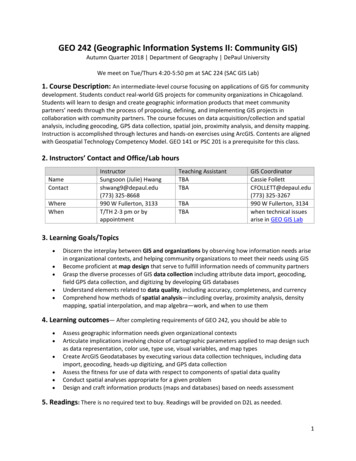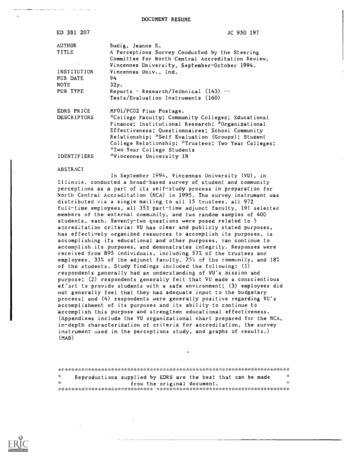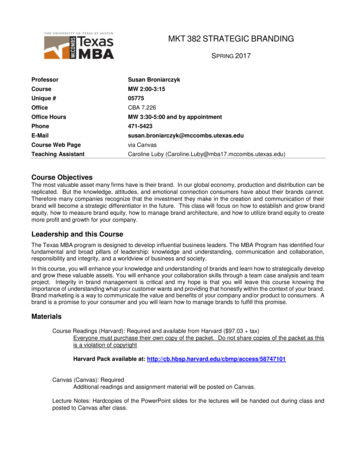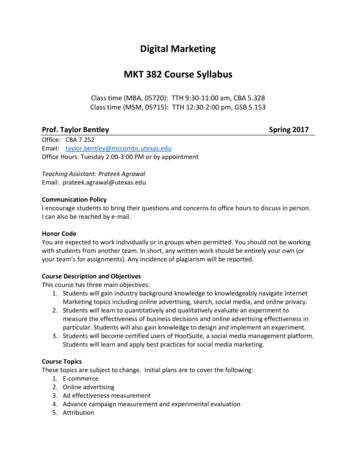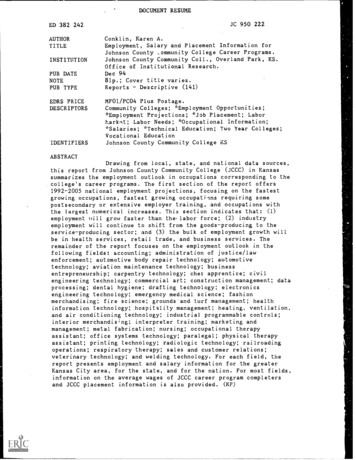
Transcription
DOCUMENT RESUMEED 382 242AUTHORTITLEINSTITUTIONPUB DATENOTEPUB TYPEEDRS PRICEDESCRIPTORSIDENTIFIERSJC 950 222Conklin, Karen A.Employment, Salary and Placement Information forJohnson County ommunity College Career Programs.Johnson County Community Coll., Overland Park, KS.Office of Institutional Research.Dec 9481p.; Cover title varies.Descriptive (141)ReportsMFOI/PC04 Plus Postage.Community Colleges; *Employment Opportunities;*Employment Projections; *Job Placement; Laborharki-it; Labor Needs; *Occupational Information;*Salaries; *Technical Education; Two Year Colleges;Vocational EducationJohnson County Community College KSABSTRACTDrawing from local, state, and national data sources,this report from Johnson County Community College (JCCC) in Kansassummarizes the employment outlook in occupations corresponding to thecollege's career programs. The first section of the report offers1992-2005 national employment projections, focusing on the fastestgrowing occupations, fastest growing occupations requiring somepostsecondary or extensive employer training, and occupations withthe largest numerical increases. This section indicates that: (1)employment gill grow faster than the labor force; (2) industryemployment will continue to shift from the goods-producing to theservice-producing sector; and (3) the bulk of employment growth willbe in health services, retail trade, and business services. Theremainder of the report focuses on the employment outlook in thefollowing fields: accounting; administration of justice/lawenforcement; automotive body repair technology; automotivetechnology; aviation maintenance technology; businessentrepreneurship; carpentry technology; chef apprentice; civilengineering technology; commercial art; construction management; dataprocessing; dental hygiene; drafting technology; electronicsengineering technology; emergency medical science; fashionmerchandising; fire science; grounds and turf management; healthinformation technology; hospitality management; heating, ventilation,and air conditioning technology; industrial programmable controls;interior merchandisng; interpreter training; marketing andmanagement; metal fabrication; nursing; occupational therapyassistant; office systems technology; paralegal; physical therapyassistant; printing technology; radiologic technology; railroadingoperations; respiratory therapy; sales and customer relations;veterinary technology; and welding technology. For each field, thereport presents employment and salary information for the greaterKansas City area, for the state, and for the nation. For most fields,information on the average wages of JCCC career program completersand JCCC placement information is also provided. (KP)
NNNEMPLOYMENT, SALARY AND PLACEMENT INFORMATIONRelated to Career Programs at Johnson County Community College00(2)L.I-1/WNY/RCP'TAWgrWrg\.6'fapppril,he AN!-PERMISSION TO REPRODUCE THISMATERIAL HAS BEEN GRANTED BYD. DoucetteTO THE EDUCATIONAL RESOURCESINFORMATION CENTER (ERIC)."DECEMBER 1994OFFICE OF INSTITUTIONAL RESEARCHJOHNSON COUNTY COMMUNITY COLLEGEU S DEPARTMENT OF EDUCATION()Litre of I clurabonal FIrseivrl,Inv,overnonlEDUCATIONAL RESOURCES INFORMATIONCENTER (ERIC)his document has boon reproduced aseceived from the person or organizationoriginating itBEST COPY AVAILABLE6U Minor changes have been made toimprove reproduction qualityPoints of view or opinions slated in thisdocument do not necessarily ropresentollicial OEM position or policy
EMPLOYMENT, SALARY & PLACEMENTINFORMATION FORJOHNSON COUNTY COMMUNITY COLLEGECAREER PROGRAMSKaren A. Conklin, M.S.Market & Survey Research AnalystOffice of Institutional ResearchJohnson County Community College12345 College BoulevardOverland Park, KS 66210-1299(913) 469-8500, Ext. 3443
TABLE OF CONTENTSPageINTRODUCTION5List of Sources6Fastest Growing Occupations, Projected 1992-20057Fastest Growing Occupations Requiring SomePostsecondary or Extensive EmployerTraining: Projected 1992-20058Occupations WW1 the Largest NumericalIncreases, Projected 1992-20059CAREER PROGRAM OUTLOOKSAccounting10Administration of Justice/Law Enforcement12Automotive Body Repair Technology14Automotive Technology16Aviation Maintenance Technology18Business Entrepreneurship78Carpentry Technology20Chef Apprentice22Civil Engineering Technology24Commercial Art26Construction Management28Data Processing30Dental Hygiene32Drafting Technology34
PageElectronics Engineering Technology36Emergency Medical Science38Fashion Merchandising40Fire Science42Gmunds and Turf Management44Health Information Technology46Hospitality Management48HVAC Technology50industrial Programmable Controls78Interior Merchandising52Interpreter Training78Marketing and Management54Metal Fabrication56Nursing58Occupational Therapy Assistant60Office Systems Technology62Paralegal64Physical Therapy Assistant60Printing Technology66Radiologic Technology68Railr6ading Operations70Respiratory Therapy72Sales and Customer Relations74Veterinary Technology79Welding Technology76
INTRODUCTIONPreparation for tomorrow's jobs and the challenges posed by the new world economy willrequire an American work force that can adapt to changing workplace requirements, accordingto Robert B. Reich, Secretary of Labor. Global competition, changing technology andbusiness practices, and shifts in the demand for goods and services are reshaping the Americanjob marketmaking the need for comprehensive, up-to-date, and reliable career informationmore important than ever before.Although workers with all levels of education and training will continue to be in demand,advancement opportunities generally will be best for those with the most education andtraining. Continued faster than average employment growth is expected among occupationsthat require relatively high levels of education or training.General PredictionsOver the 1992-2005 period, employment will grow faster than the labor force and more than itdid from 1979-1992. Industry employment will continue to shift from the goods-producing tothe service-producing sector of the economy, but the shift will be less pronounced than duringthe previous 13 years.As in the past, the bulk of the employment growth will be in three industries: health services;retail trade (including eating and drinking establishments); and business services (includingtemporary help supply services, computer and data processing services, and services tobuildings). Service-producing industries are expected to account for approximately 24.5million of the 26.4 million job growth over the 1992-2005 period.On the average, employment will grow faster in the major occupational groups that require themost education and training. Service and professional occupations--particularly in the fields ofhealth and education dominate the lists of occupations gaining the most employment orgrowing the most rapidly.Data LimitationsThe short lists of rapidly growing occupations and occupations with large numerical growthare extremely selective. They leave out many occupations with favorable employmentprospects and relatively high earnings. For example, many engineering specialties, naturalscience disciplines, and construction crafts fall into this category. For this reason, a great dealof investigation of the projections and other information should take place before career plansare made. Projections of change are not unconditional predictions of the future, but aresubject to a variety of influences which may cause a particular industry or occupation tochange in a totally unexpected way. Consequently, readers are cautioned to utilizeemployment outlook information as a guide, rather than a guarantee of job opportunities in anygiven occupation.5p
LIST OF SOURCESLocal Data SourcesJohnson County Wage, Salary and Fringe Benefits Report 1994. Johnson County EconomicResearch Institute in cooperation with the Kansas Department of Human Resources.Follow-up of JCCC Career Program Completers: Class of 1992-93. Office of InstitutionalResearch, Johnson County Community College. August 1994.Kansas. City Employment Outlook: Projections to 2000. Occupational Information Unit,Missouri Department of Labor & Industrial Relations. December 1992.Long-Tam Follow-up Study of 1989-90 Career Program Completers. Office of InstitutionalResearch, Johnson County Community College. November 1994.Occupational Compensation Survey: Kansas City, MO-KS Metropolitan Area: July 1993.Wage Rates in Selected Occupations: Kansas. City Metro Area. Research and AnalysisSection, Missouri Division of Employment Security. July 1992.State Data SourcesKansas Wage Survey: 1992-93 Edition. Kansas Department of Human Resources, LaborMarket Information Services. June 1993.Missouri Employment Owlook: Projections to 2000. Missouri Department of Labor andIndustrial Relations. December 1992.National Data SourcesOccupational Outlook Handbook: 1994-95 Edition. U.S. Department of Labor, Bureau ofLabor Statistics. May 1994.Occupational Outlook Quarterly: A Special Issue on the American Work Force, 1992-2005.U.S. Department of Labor, Bureau of Labor Statistics. Fall 1993.Occupational Projections and Training Data: 1994 Edition. U.S. Department of Labor,Bureau of Labor Statistics. May 1994.6
FASTEST GROWING OCCUPATIONSPROJECTED 1992-2005One-third of the 30 fastest growing occupations are professional occupations. Jobs in theseoccupations generally require a bachelor's degree or more education. Fields of work having asignificant proportion of the fastest growing occupations include computer technology, healthservice, and personal service. Fast growing occupations generally have good employmentprospects and conditions favorable for advancement.Home health aideHuman services workPersonal/home careComputer engineerSystems analystPhys. therapy asst.Physical therapistParalegalSpecial ed. teacherMedical assistant71%Corrections officer70%Detective, nonpublicTravel agentChildcare workerRadiologic tech.Nursery workerMedical record tech.Operations researchOccupational therapyLegal secretaryManicuristActor/producer, etc.Preschool teacherFlight attendantSpeech 6%63% 561%61%60%54%64%64%61%61%Guard51%Ins. adjuster, etc.Respiratory therapyPsychologistRoad const. operator62%49%48%48%1111111111111110%48%20% 40% 60% 80% 100% 120% 140% 160%Percent Increase7
FASTEST GROWING OCCUPATIONS REQUIRING SOMEPOSTSECONDARY TRAINING, PROJECTED 1992-2005Health-related occupations account for 13 of the 20 fastest growing occupations requiringsome postsecondary training or extensive employer training. These occupations demonstrate agreat deal of variety with regard to earnings, number of openings, and skills required. The9" designates programs offered through Johnson County Community College.Phys. ther. asst.-JParalegal-JOccup. ther. asst.-JMedical assistantRadiologic tech.-J111111163171%Med. record tech.-JLegal secretary-JEEG technologistActor/producer, etc.Nuclear med. tech.Ins. adjuster, etc.Respiratory ther.-JRestaurant cook-J46%DP equip. repairer-J45%Medical secretary-J45%Food/lodging mgr.-J44%Dental hygienist-J43%Surgical tech.11111111111111MPharmacy assistant 01111111.11111WLPN nurse42%42%40%0%40%20%60%Percent Increase880%100%
OCCUPATIONS WITH THE LARGEST NUMERICALINCREASES, PROJECTED 1992-2005Among the 500 occupations for which projections were developed, these 25 will account forover half of total employment growth over the 1992-2005 period. Johnson County CommunityCollege offers career programs in several of these areas. However, the majority of theseoccupations require little or no formal postsecondary education. Of note is the fact that jobsrequiring little or no postsecondary education are traditionally low paying and have anunusually high turnover rate.Retail salespersonRegistered nurseCashierGem office clerkTruck driverWaiter/waitressNurse aide/orderliesJanitor/cleanerFood prep. workerSystems analystHome health aideHigh school teacherChildcare workerGuardMarketing/sales mgr.Teacher aide/asst.Gen. mgr./top exec.Maintenance repairerGardener/grdskeeperElem. teacherFountain & l supervisorRestaurant cook0400200600Thousands9108001000
ACCOUNTINGLittle change is expected in the employment of bookkeeping, accounting, and auditing clerksthrough 2005. A growing economy will result in more financial transactions and otheractivities and, therefore, more demand for accounting services. However, automation ofoffice functions is expected to continue, with resulting productivity increases. Virtually allnew jobs will be created in small, rapidly growing organizations. Large organizations arelikely to continue the consolidation of departments to eliminate duplicate functions and reducethe demand for these clerks.Employment InformationGreater Kansas City Area: Approximately 15,711 bookkeeping and accounting clerkswere employed in the Greater Kansas City area in 1990, with 15,230 jobs projected bythe year 2000 (-3.1%). An average of 313 annual openings are anticipated due to theneed for replacements.State: Bookkeeping, accounting and auditing clerks held 46,131 jobs in Missouri in1990, with 43,970 jobs projected by the year 2000 (-4.7%). Approximately 918 averageannual openings are projects due to replacements. Recent data are unavailable forKansas.National: Bookkeeping, accounting and auditing clerks held 2,112,000 jobs in 1992,with 2,186,000 jobs projected by the year 2005 ( 3.5%). Approximately 342,000annual openings are anticipated, including replacements.Salary InformationJohnson County: The average hourly wage for bookkeeping, accounting and auditingclerks was between A.92 and 10.26 in 1994. The lowest reported wage was under 5.12, the highest was over 20.95, and the median entry-level wage was 7.28 perhour.State: Bookkeeping, accounting, and auditing clerks in Kansas earned between 7.98and 9.18 on the average in 1993. The lowest reported wage was under 4.44, thehighest was over 20.95, and the average entry-level wage was 6.23 per hour.1011
National: Bookkeeping, accounting, and auditing clerks earned a median hourly wage of 9.25 in 1990. However, region of the country, size of city, and type and size ofestablishment all influence salary levas. The level of industry or technical expertiserequired and the complexity and uniqueness of a clerk's responsibilities may also affectearnings.JCCC Career Program Completers: An average hourly wage of 11.35 was reported bythe 1992-93 accounting program completers responding to the January 1994 short-termfollow-up study who were working full-time in a job related to accounting.An average hourly wage of 9.17 was reported by 1989-90 accounting programcompleters working full-time in a related job who responded to the long-term follow-upstudy conducted in 1994.ICCC Placement InformationAll of the accounting program completers responding to the short-term follow-up of1992-93 JCCC career program completers were working in a job :elated to accounting.Fully 75% of the 1989-90 accounting program completers contacted in 1994 wereemployed in a job related to accounting, and 25% were working in v -elated jobs.Dints.Salary and placement information for JCCC career program completers is based on data supplied byrespondents to follow-up studies and is not necessarily representative of all career program completers.11f".
ADMMISTRATION OF JUSTICE/LAW ENFORCEMENTAlthough employment of police officers, detectives, and special agents is expected to increasemore slowly than the average for all occupations through the year 2005, the outlook for lawenforcement occupations in general remains positive. Caution should be exercised wheninterpreting the projected number of jobs in this career field, however, due to uncertainties inthe level of government spending for law enforcement in the future. Because of attractivesalaries and benefits, the number of qualified candidates generally exceeds the number of jobopenings, and competition is expected to remain keen. for higher paying jobs in larger policedepartments. Persons having college training in law enforcement should have the bestopportunities.Employment InformationGreater Kansas City Area: A total of 4,473 workers were employed as patrol officers,detectives, supervisors, corrections officers, federal marshalls, criminal investigators,sheriffs, and other law enforcement officers in the Greater Kansas City. area in 1990.Approximately 4,904 jobs are projected by the year 2000 ( 9.6%), with 170 averageannual job openings, including replacements, anticipated. Approximately 545 workerswere employed as dispatchers in 1990, with 569 jobs projected by the year 2000( 4.4%), with 12 average annual openings, including replacements, anticipated.State: A total of 16,321 workers were employed in law enforcement jobs in Missouri in1990, with 19,757 jobs projected by the year 2000 ( 21.1%). Approximately 791average annual openings, including replacements, are anticipated. Recent data areunavailable for Kansas.National: Approximately 982,000 individuals were employed in law enforcementoccupations in 1992, with 1,271,000 jobs projected by 2005 ( 29.4%). An average of76,000 annual openings are anticipated, including replacements.Salary InformationJohnson County: The median hourly wage was between 13.76 and 15.92 for policepatrol officers and between 15.83 and 18.20 for police detectives in 1994. Averageentry-level wages for police patrol officers was 10.36 per hour in the Greater KansasCity area in 1993.1213
State: The average hourly wages in Kansas were between 10.35 and 11.90 for policepatrol officers, between 13.39 and 15.39 for police detectives, and between 14.12and 16.23 for police and detective supervisors in 1993. Average entry-level wageswere 9.22 for patrol officers, 10.10 for detectives, and 10.91 for supervisors.National: In 1992, the median wage of nonsupervisory police officers and detectiveswas about 15.40 per hour. The highest paid 10% earned over 51,200 a year, and thelowest paid 10% were paid less than 8.85 an hour. Generally, salaries tend to be higherin larger, more urban jurisdictions that usually have bigger police departments.Total earnings frequently exceed the stated salary due to payments for overtime, whichcan be significant, especially during criminal investigations or when police are needed forcrowd control during sporting events or political rallies.JCCC Program Completers: An average hourly wage of 12.69 was reported by1992-93 police academy graduates responding to the January 1994 short-term follow-upstudy who were working full-time as police officers. Administration of justice programcompleters responding to the 1994 short-term follow-up study who were working fulltime in a related job also reported average hourly earnings of 12.69.An average hourly wage of 14.88 was reported by 1989-90 police academy graduateswho were working full-time in a related job who responded to the 1994 long-termfollow-up study.JCCC Placement InformationHalf of the 1992-93 administration of justice program completers responding to theJanuary 1994 follow-up study were employed in jobs related to administration of justice;37% were employed in unrelated jobs, 6% were pursuing additional education, and 6%were serving in the military. All of the police academy graduates were employed in jobsrelated to their police academy training.Half of the 1989-90 administration of justice program completers responding to the 1994long-term follow-up study were working in a job related to administration of justice, andhalf were employed in an unrelated job. All of the police academy graduates respondingto the 1994 long-term follow-up study were employed in a related job.Note.Salary and placement information for JCCC career program completers is based on data supplied byrespondents to follow-up studies and is not necessarily representative of all career program completers.
AUTOM
JOHNSON COUNTY COMMUNITY COLLEGE CAREER PROGRAMS. Karen A. Conklin, M.S. Market & Survey Research Analyst Office of Institutional Research Johnson County Community College. 12345 College Bouleva
